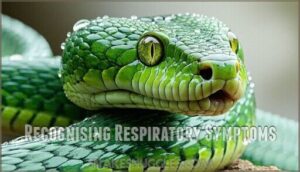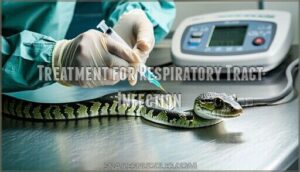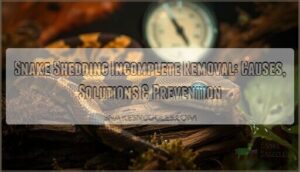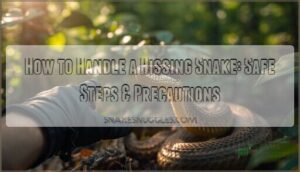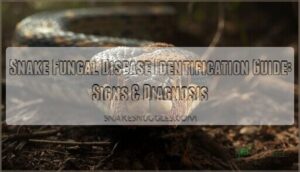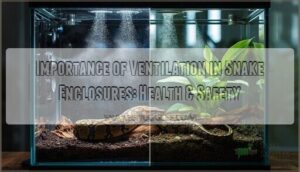This site is supported by our readers. We may earn a commission, at no cost to you, if you purchase through links.
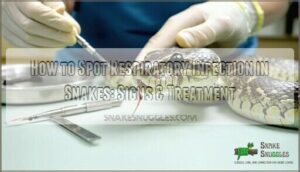
Listen for wheezing, clicking sounds, or audible breathing – healthy snakes are silent breathers.
Check for mouth breathing, nasal discharge, or excess saliva around the mouth.
Your snake might hold its head elevated or seem lethargic, like it’s fighting off a cold.
Look for irregular breathing patterns or gasping motions.
These infections often strike when temperatures drop or humidity levels swing wildly.
Think of it as your snake’s way of waving a white flag – these symptoms mean it’s time for veterinary intervention before things get worse.
Table Of Contents
- Key Takeaways
- How to Spot Respiratory Infection in Snakes?
- Recognizing Symptoms of Respiratory Infection
- Signs of Respiratory Tract Infection (RTI)
- Diagnosing Respiratory Tract Infection
- Treatment for Respiratory Tract Infection
- Preventing Respiratory Tract Infection
- Frequently Asked Questions (FAQs)
- How do you know if a snake has a respiratory infection?
- What causes respiratory infections in snakes?
- Do snakes have respiratory problems?
- What causes respiratory distress in snakes?
- How do you treat a respiratory infection in a snake?
- What should I do if my snake has a virus?
- How to tell if a snake has a respiratory infection?
- Will snake respiratory infection go away on its own?
- How do you know if a snake is infected?
- How do you treat upper respiratory infection in reptiles?
- Conclusion
Key Takeaways
- Listen for unusual breathing sounds – You’ll hear wheezing, clicking, or gasping noises when your snake has a respiratory infection, since healthy snakes breathe silently.
- Watch for visible symptoms around the mouth and nose – Look for mouth breathing, nasal discharge, excess saliva, or mucus that’s thick or colored, which signals trouble.
- Notice behavioral changes – Your snake might hold its head elevated to breathe easier, become lethargic, lose appetite, or show restlessness indicating discomfort.
- Don’t wait to seek veterinary care – Respiratory infections won’t heal on their own and require antibiotics, proper diagnosis through X-rays or blood work, and supportive care to prevent serious complications.
How to Spot Respiratory Infection in Snakes?
When your snake’s breathing doesn’t sound right, you’re likely dealing with a respiratory infection. Watch for unusual breathing sounds like wheezing or clicking noises that weren’t there before.
Trust your ears – unusual breathing sounds are your snake’s cry for help.
Mucus discharge around the nose or mouth signals trouble, especially if it’s thick or colored. Notice posture changes too – snakes often stretch their necks or hold their heads up when struggling to breathe.
Appetite loss is another red flag; healthy snakes rarely refuse food. Pale or bluish tints indicate serious snake breathing problems requiring immediate veterinary attention.
Radiographs are essential for visualizing lung abnormalities and confirming pneumonia. Check membrane color inside the mouth to ensure your snake’s health is not at risk due to serious breathing problems.
Recognizing Symptoms of Respiratory Infection
You’ll need to watch for several key warning signs that indicate your snake’s breathing system isn’t working properly.
Think of it like being a detective – you’re looking for clues such as wheezing sounds, mouth breathing, nasal discharge, and changes in your snake’s normal behavior that signal trouble ahead.
Recognising Respiratory Symptoms
Wheezing sounds and nasal discharge are telltale signs your snake’s struggling.
Watch for open-mouth breathing – it’s like watching someone gasp for air.
Mucus production around the nose creates bubbly foam, while lethargy signs show your normally active pet becoming a couch potato.
These snake respiratory infection symptoms mean snake breathing problems need immediate attention before they worsen.
Environmental factors can also contribute, so be mindful of potential air pollutants.
Causes & Risk Factors
Understanding what triggers snake respiratory infection helps you protect your pet.
Poor hygiene creates breeding grounds for bacteria, while temperature fluctuations weaken immunity.
Stress factors from overcrowding or excessive handling make snakes vulnerable to pathogen exposure.
Environmental factors like inadequate ventilation and poor husbandry issues set the stage for infection.
Your snake’s health depends on controlling these risks.
In fact, a study showed that respiratory issues in snakes were reported in over 5% of surveyed snake owners, highlighting the importance of proper hygiene and good husbandry.
Diagnosis & Treatment
When you’ve identified those telltale snake RI symptoms, it’s time for a veterinary consultation. Your snake vet will recommend specific medication options like antibiotics for bacterial infections.
Treatment combines prescribed snake antibiotics with supportive therapies including proper heating and humidity. Many owners find success with snake respiratory medication.
Home care involves monitoring breathing patterns closely. Long-term management requires consistent environmental conditions to prevent recurring snake respiratory infection episodes, which is crucial for the snake’s health and involves proper heating.
Signs of Respiratory Tract Infection (RTI)
Spotting a respiratory tract infection requires watching for several telltale signs. Wheezing sounds during breathing often signal airway obstruction, while nasal discharge appears as colored mucus around the nostrils.
You’ll notice open-mouth breathing when your snake struggles for air, accompanied by visible mucus production in the mouth. Lethargy signs include reduced activity and loss of appetite.
Watch for gurgling noises, extended neck posture, and restlessness indicating discomfort. Aquatic species may float unevenly or swim abnormally.
These snake respiratory infection symptoms shouldn’t be ignored—they’re your snake’s way of telling you something’s wrong. If the snake shows severe shortness of breath, seek immediate veterinary attention.
Diagnosing Respiratory Tract Infection
Once you’ve spotted those telltale signs of wheezing and mucus discharge, you’ll need your exotic vet to confirm what’s really going on inside your snake’s respiratory system.
Your vet will use specialized tests like X-rays and blood work to pinpoint the exact cause and severity of the infection, giving you the roadmap for effective treatment.
Radiographs (X-rays)
When examining your snake for respiratory issues, X-rays offer a clear window into what’s happening inside. These diagnostic images help veterinarians spot problems that aren’t visible from the outside, making radiograph interpretation a powerful tool for snake disease diagnosis.
Snake X-rays can reveal several important findings:
- Pneumonia detection through fluid buildup or inflammation in lung tissue
- Foreign bodies lodged in airways or digestive tract
- Skeletal abnormalities that might compress breathing passages
Your vet might use contrast radiography for detailed views of specific areas. This imaging technique transforms guesswork into certainty, helping identify the exact cause of your snake’s respiratory disease symptoms.
Blood Work and Fecal Sample Evaluation
After X-rays provide structural insights, your vet will likely recommend blood work and fecal sample evaluation to complete the diagnostic picture.
Think of these tests as your snake’s health report card – they reveal what’s happening inside.
Blood cell count tests show if your snake’s immune system is fighting an infection.
Low white blood cell counts might indicate a weakened immune response, while elevated levels suggest active infection.
The blood work also checks organ function and hydration status, helping your vet understand how the respiratory infection affects your snake’s overall health.
Fecal sample evaluation focuses on parasite identification.
Internal parasites can weaken your snake’s immune system, making respiratory infections worse.
Your vet will examine the sample under a microscope, looking for eggs, larvae, or adult parasites that need treatment alongside the respiratory infection.
The microbiology lab plays a critical role in diagnosing these infections.
These diagnostic tools enable early detection and guide targeted treatment plans for your snake’s recovery.
Respiratory Pathogen Testing
After blood work reveals infection markers, your vet will likely recommend respiratory pathogen testing to pinpoint the exact culprit behind your snake’s respiratory infection.
This targeted approach saves precious time when your pet’s breathing is compromised.
Modern diagnostic techniques offer several powerful options:
- PCR testing – Detects specific genetic material from bacteria, viruses, and fungi with remarkable accuracy, providing results faster than traditional culture methods
- Culture methods – Grows pathogens in laboratory conditions, allowing sensitivity analysis to determine which antibiotics work best
- Sample collection – Involves gentle swabbing of the mouth, throat, or nasal passages without causing additional stress
- Turnaround time – Most results arrive within 24-72 hours, enabling prompt treatment decisions
This precision helps distinguish between bacterial infection, viral infection, and fungal infection cases.
Treatment for Respiratory Tract Infection
Once you’ve confirmed your snake has a respiratory infection, you’ll need to act quickly with proper veterinary treatment to prevent the condition from worsening.
Your vet will likely prescribe antibiotics like enrofloxacin for bacterial infections, while also recommending supportive care such as adjusted temperatures and humidity levels to help your snake’s immune system fight back.
Antibiotics, Anti-parasitic Drugs, Anti-fungal Medications
Once your vet confirms the diagnosis, they’ll prescribe targeted medications. Antibiotics like enrofloxacin tackle snake bacterial infection, while antifungal medications combat fungal problems. Antiparasitic drugs handle worm-related issues.
Your vet will handle dosage calculation based on your snake’s weight and condition.
Never skip doses or stop treatment early—this creates antibiotic resistance. Watch for medication side-effects like loss of appetite or unusual behavior. Some medications have drug interactions, so tell your vet about any other treatments.
Preventative medication isn’t typically used in snakes. Stick to prescribed treatments and complete the full course, even when your snake looks better.
Supportive Care and Proper Temperature Management
Beyond medication, your snake needs three essential supportive measures for snake respiratory infection recovery.
First, maintain proper hydration methods through shallow water dishes and gentle soaks.
Second, establish precise thermogradient setup with environmental temperature at 85-90°F to boost immunity.
Third, prioritize enclosure hygiene with daily spot-cleaning.
Heat support accelerates healing while appetite stimulation aids recovery.
Providing proper water sources is essential for hydration.
Schedule veterinary follow-up to monitor progress and adjust snake husbandry practices accordingly, focusing on recovery.
Preventing Respiratory Tract Infection
You’ll find that keeping your snake healthy starts with maintaining proper temperature gradients between 75-80°F on the cool side and 80-85°F on the warm side.
Along with humidity levels between 40-60%, clean enclosures weekly, quarantine new snakes for 30 days, and you’ll prevent most respiratory infections before they can take hold.
Suitable Husbandry Practices
Creating the perfect environment for your snake isn’t rocket science, but it requires attention to detail.
Proper snake husbandry prevents most respiratory infections through these essential practices:
- Enclosure Size: Provide adequate space for natural movement and thermoregulation
- Substrate Choice: Use appropriate bedding that maintains humidity without harboring bacteria
- Water Availability: Offer fresh, clean water in properly-sized bowls daily
- Hiding Spots: Install multiple secure retreats throughout the habitat
- Enrichment Items: Add climbing structures and exploration opportunities for mental stimulation
Selecting the right enclosure is key, so consider appropriate habitat dimensions.
Temperature Regulation and Habitat Cleaning
Proper temperature regulation and habitat cleaning form your snake’s first line of defense against respiratory infections. Think of your snake’s enclosure as their personal climate-controlled sanctuary where every detail matters.
Here are three essential prevention strategies:
- Create precise heating gradients with basking spots at 95°F and cool zones at 75°F, allowing natural thermoregulation while supporting immune function through ideal temperature ranges.
- Master humidity control methods by maintaining 40-60% humidity levels using hygrometers, proper ventilation importance, and substrate choice that prevents moisture buildup without creating desert conditions.
- Implement strict disinfection protocols through weekly enclosure maintenance, monthly deep cleaning with reptile-safe disinfectants, and daily spot-cleaning to eliminate bacterial breeding grounds that compromise respiratory health.
Regular check-ups can facilitate early detection of issues before they escalate.
Frequently Asked Questions (FAQs)
How do you know if a snake has a respiratory infection?
Watch for wheezing sounds, open-mouth breathing, and mucus discharge around the nose or mouth.
You’ll also notice lethargy, loss of appetite, and your snake holding its head in an elevated position to breathe easier, which can be a clear sign of distress.
What causes respiratory infections in snakes?
Poor husbandry triggers most respiratory infections in your snake.
You’ll see problems from incorrect temperatures, wrong humidity levels, dirty enclosures, poor ventilation, stress, and exposure to bacteria, viruses, or fungi through contaminated environments.
Do snakes have respiratory problems?
Like a canary in a coal mine, your snake’s breathing tells the whole story.
Yes, snakes definitely get respiratory problems from poor husbandry, stress, and infections.
You’ll notice wheezing, mouth breathing, and lethargy.
What causes respiratory distress in snakes?
Cold temperatures weaken your snake’s immune system, making them vulnerable to bacterial, viral, or fungal infections.
High humidity, poor ventilation, dirty enclosures, and stress from improper handling also trigger respiratory distress.
How do you treat a respiratory infection in a snake?
You’ll need a reptile vet for proper antibiotics like enrofloxacin.
Meanwhile, boost enclosure temperatures to the higher range, maintain 50-60% humidity, and provide supportive care with hydration until professional treatment begins.
What should I do if my snake has a virus?
When viral storms hit your snake, you’ll need professional help fast.
Contact an exotic veterinarian immediately—there’s no home cure for viral infections.
Focus on supportive care, ideal temperatures, and reducing stress while following veterinary guidance.
How to tell if a snake has a respiratory infection?
Watch for wheezing sounds, open-mouth breathing, and mucus discharge around your snake’s nose or mouth.
You’ll also notice lethargy, loss of appetite, and difficulty moving.
These symptoms together signal respiratory trouble.
Will snake respiratory infection go away on its own?
Don’t hold your breath waiting for a snake’s respiratory infection to heal itself.
These infections won’t disappear without proper veterinary treatment—antibiotics, temperature adjustments, and supportive care are essential for recovery.
They require proper veterinary treatment to ensure the snake recovers fully from the infection.
How do you know if a snake is infected?
You’ll notice your snake breathing with its mouth open, making wheezing or gurgling sounds, showing nasal discharge, acting lethargic, and losing appetite.
These telltale signs mean it’s time for a vet visit.
How do you treat upper respiratory infection in reptiles?
Think your reptile’s struggling to breathe? You’ll need antibiotics like enrofloxacin from an exotic vet, plus improved husbandry with proper temperatures and humidity. Nebulization therapy and supportive care help too.
Conclusion
Catching respiratory infections early can make the difference between a quick recovery and a serious health crisis for your snake.
By learning how to spot respiratory infection in snakes through these warning signs—wheezing, mouth breathing, and lethargy—you’re equipped to act fast.
Remember, proper husbandry prevents most cases, but when symptoms appear, don’t hesitate to contact your exotic veterinarian.
Your snake’s health depends on your vigilance and quick response to these telltale respiratory warning signs.
- https://vcahospitals.com/know-your-pet/snakes-diseases
- https://bioone.org/journals/journal-of-herpetological-medicine-and-surgery/volume-33/issue-4/JHMS-D-23-00010/Ophidian-Serpentoviruses-A-Review-and-Perspective/10.5818/JHMS-D-23-00010.short
- https://www.vetexotic.theclinics.com/article/S1094-9194(02)00020-8/pdf
- https://www.frontiersin.org/journals/veterinary-science/articles/10.3389/fvets.2021.733404/full
- https://www.sciencedirect.com/science/article/pii/S0042682217304130

